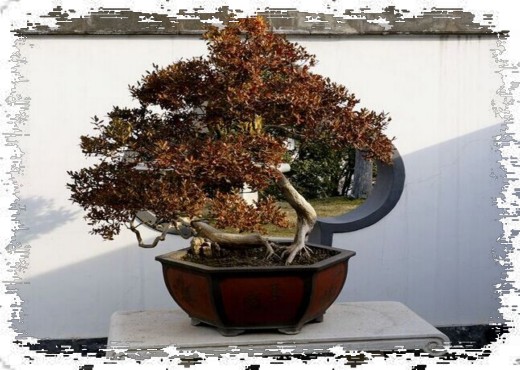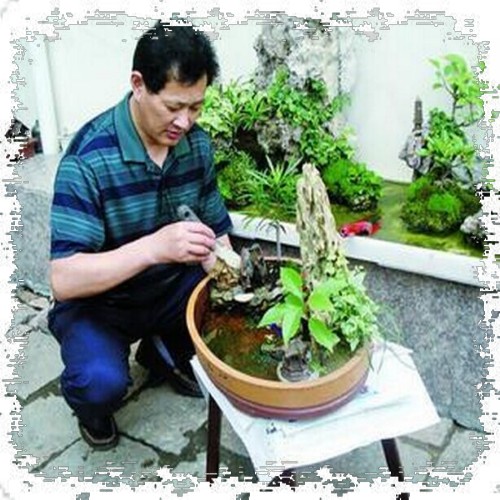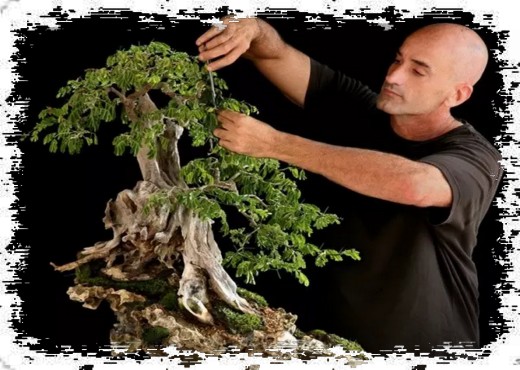The artistic style characteristics of Jinling Bonsai
Bonsai is a traditional art in China with a long history. It originated in Tang Dynasty, developed in Song Dynasty and flourished in Ming and Qing dynasties. Among them, Jinling bonsai has a rich artistic style and distinctive features, which depends on the production materials and skills.

First, Jinling bonsai materials, focusing on local unique or suitable for local growth of plants and local rocks, such as five-needle pine, cedar, sparrow plum, hammer elm, red maple, June snow, plum blossom, orange wood, Laoya persimmon, Elaeagnus angustifolia, begonia, woody honeysuckle and so on. There are more than 40 kinds of stone materials, such as Zijinshan purple stone, Qixia mountain stone, Jiangpu pumice stone, Laoshan sand stone, Fangshan volcanic stone, Qinglong Mountain Taihu stone, Yuhua stone, etc.
Second, Jinling bonsai modeling, focusing on close to nature, fully reflected by the use of big trees and water-facing types, with the characteristics of "shallow basin thin soil, bare roots exposed dry, floating clouds elegant, natural shape".
Third, the method of space modeling skills, abide by the principle of acting in accordance with their aptitude and modeling according to the situation, with wire binding and shaping, supplemented by pruning.
Fourth, the artistic style follows the shallow strange and fresh, vigorous and clumsy, chic and elegant, natural and unrestrained.
The main features of Jinling bonsai art:
1. Pay attention to artistic conception, and strive to be poetic and picturesque.
2. The composition highlights the main body, and the layout emphasizes the unity of contrast. The work strives to integrate natural beauty with artistic beauty.
3. A wide range of materials are drawn, with emphasis on local plants and rocks.
4. apply art in accordance with their aptitude and shape with the trend. The works emphasize hanging roots, revealing, branching naturally, and avoid rigid distortion and affectation.
5. Draw lessons from the painting theory of Jinling School of painting, and advocate that you should learn from nature without showing traces of artificial work.
6. Shallow basin and thin soil, carefully managed and protected, pile scene full of vitality.
Jinling bonsai works with elegant ideas, concise and exquisite composition, natural, unrestrained, elegant, clumsy, fresh, shallow and strange, beautiful shape to win.
Time: 2019-05-23 Click:
- Prev

Master-slave relationship in bonsai creation
Primary and secondary, also known as principal and subordinate, principal appreciation (object), partial perfection, etc., is one of the important rules of formal beauty. In any work of art, the relationship between each department cannot be equal, and there must be a distinction between the primary and the secondary. In the creation of bonsai, we should also highlight the subject and object, so there should be a clear distinction between the host and the guest.
- Next

How to create bonsai with far-reaching artistic conception
Bonsai, like poetry, painting and garden art, all originate from nature and life, but they have different forms of expression. They permeate each other and learn from each other. Poems and paintings are often drawn from gardens and bonsai, and the creation of gardens and bonsai emphasizes poetic and picturesque. therefore
Related
- Fuxing push coffee new agricultural production and marketing class: lack of small-scale processing plants
- Jujube rice field leisure farm deep ploughing Yilan for five years to create a space for organic food and play
- Nongyu Farm-A trial of organic papaya for brave women with advanced technology
- Four points for attention in the prevention and control of diseases and insect pests of edible fungi
- How to add nutrient solution to Edible Fungi
- Is there any good way to control edible fungus mites?
- Open Inoculation Technology of Edible Fungi
- Is there any clever way to use fertilizer for edible fungus in winter?
- What agents are used to kill the pathogens of edible fungi in the mushroom shed?
- Rapid drying of Edible Fungi

